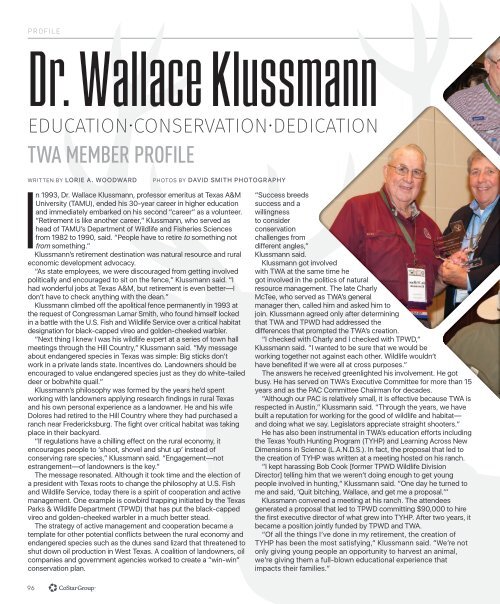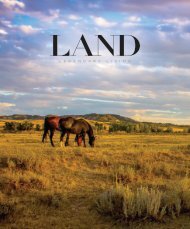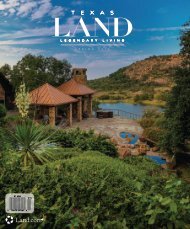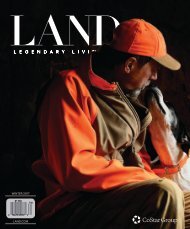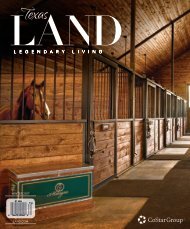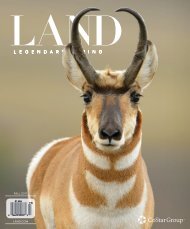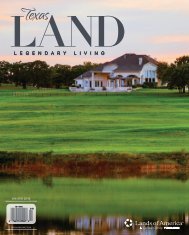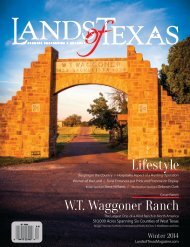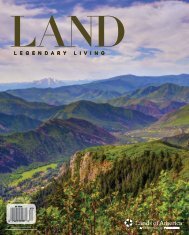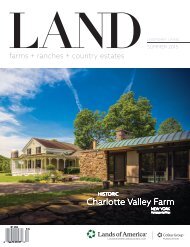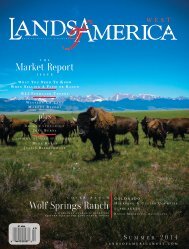Create successful ePaper yourself
Turn your PDF publications into a flip-book with our unique Google optimized e-Paper software.
PROFILE<br />
Dr. Wallace Klussmann<br />
EDUCATION•CONSERVATION•DEDICATION<br />
TWA MEMBER PROFILE<br />
WRITTEN BY LORIE A. WOODWARD<br />
PHOTOS BY DAVID SMITH PHOTOGRAPHY<br />
In 1993, Dr. Wallace Klussmann, professor emeritus at Texas A&M<br />
University (TAMU), ended his 30-year career in higher education<br />
and immediately embarked on his second “career” as a volunteer.<br />
“Retirement is like another career,” Klussmann, who served as<br />
head of TAMU’s Department of Wildlife and Fisheries Sciences<br />
from 1982 to 1990, said. “People have to retire to something not<br />
from something.”<br />
Klussmann’s retirement destination was natural resource and rural<br />
economic development advocacy.<br />
“As state employees, we were discouraged from getting involved<br />
politically and encouraged to sit on the fence,” Klussmann said. “I<br />
had wonderful jobs at Texas A&M, but retirement is even better—I<br />
don’t have to check anything with the dean.”<br />
Klussmann climbed off the apolitical fence permanently in 1993 at<br />
the request of Congressman Lamar Smith, who found himself locked<br />
in a battle with the U.S. Fish and Wildlife Service over a critical habitat<br />
designation for black-capped vireo and golden-cheeked warbler.<br />
“Next thing I knew I was his wildlife expert at a series of town hall<br />
meetings through the Hill Country,” Klussmann said. “My message<br />
about endangered species in Texas was simple: Big sticks don’t<br />
work in a private lands state. Incentives do. Landowners should be<br />
encouraged to value endangered species just as they do white-tailed<br />
deer or bobwhite quail.”<br />
Klussmann’s philosophy was formed by the years he’d spent<br />
working with landowners applying research findings in rural Texas<br />
and his own personal experience as a landowner. He and his wife<br />
Dolores had retired to the Hill Country where they had purchased a<br />
ranch near Fredericksburg. The fight over critical habitat was taking<br />
place in their backyard.<br />
“If regulations have a chilling effect on the rural economy, it<br />
encourages people to ‘shoot, shovel and shut up’ instead of<br />
conserving rare species,” Klussmann said. “Engagement—not<br />
estrangement—of landowners is the key.”<br />
The message resonated. Although it took time and the election of<br />
a president with Texas roots to change the philosophy at U.S. Fish<br />
and Wildlife Service, today there is a spirit of cooperation and active<br />
management. One example is cowbird trapping initiated by the Texas<br />
Parks & Wildlife Department (TPWD) that has put the black-capped<br />
vireo and golden-cheeked warbler in a much better stead.<br />
The strategy of active management and cooperation became a<br />
template for other potential conflicts between the rural economy and<br />
endangered species such as the dunes sand lizard that threatened to<br />
shut down oil production in West Texas. A coalition of landowners, oil<br />
companies and government agencies worked to create a “win-win”<br />
conservation plan.<br />
“Success breeds<br />
success and a<br />
willingness<br />
to consider<br />
conservation<br />
challenges from<br />
different angles,”<br />
Klussmann said.<br />
Klussmann got involved<br />
with TWA at the same time he<br />
got involved in the politics of natural<br />
resource management. The late Charly<br />
McTee, who served as TWA’s general<br />
manager then, called him and asked him to<br />
join. Klussmann agreed only after determining<br />
that TWA and TPWD had addressed the<br />
differences that prompted the TWA’s creation.<br />
“I checked with Charly and I checked with TPWD,”<br />
Klussmann said. “I wanted to be sure that we would be<br />
working together not against each other. Wildlife wouldn’t<br />
have benefited if we were all at cross purposes.”<br />
The answers he received greenlighted his involvement. He got<br />
busy. He has served on TWA’s Executive Committee for more than 15<br />
years and as the PAC Committee Chairman for decades.<br />
“Although our PAC is relatively small, it is effective because TWA is<br />
respected in Austin,” Klussmann said. “Through the years, we have<br />
built a reputation for working for the good of wildlife and habitat—<br />
and doing what we say. Legislators appreciate straight shooters.”<br />
He has also been instrumental in TWA’s education efforts including<br />
the Texas Youth Hunting Program (TYHP) and Learning Across New<br />
Dimensions in Science (L.A.N.D.S.). In fact, the proposal that led to<br />
the creation of TYHP was written at a meeting hosted on his ranch.<br />
“I kept harassing Bob Cook [former TPWD Wildlife Division<br />
Director] telling him that we weren’t doing enough to get young<br />
people involved in hunting,” Klussmann said. “One day he turned to<br />
me and said, ‘Quit bitching, Wallace, and get me a proposal.’”<br />
Klussmann convened a meeting at his ranch. The attendees<br />
generated a proposal that led to TPWD committing $90,000 to hire<br />
the first executive director of what grew into TYHP. After two years, it<br />
became a position jointly funded by TPWD and TWA.<br />
“Of all the things I’ve done in my retirement, the creation of<br />
TYHP has been the most satisfying,” Klussmann said. “We’re not<br />
only giving young people an opportunity to harvest an animal,<br />
we’re giving them a full-blown educational experience that<br />
impacts their families.”<br />
96


